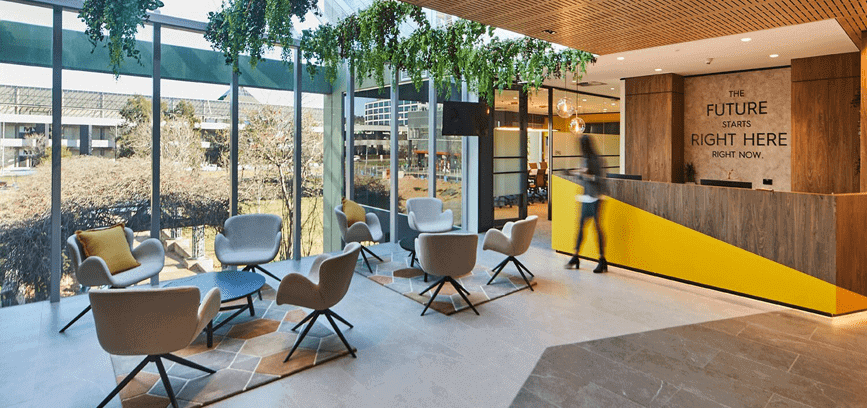How to prepare now for the workplace of the future
In the last 18 months, the “workplace of the future” has accelerated faster than we could have imagined. No longer are we...
In today’s rapidly evolving digital landscape, the future of work isn’t just a buzzword—it’s a critical concept shaping how businesses operate, hire, and adapt. From the rise of remote work and AI-driven automation to the growing importance of employee well-being and flexible work models, this transformation affects every industry. Organizations that recognize and plan for these changes in the workplace today—through future workplace strategy, technology adoption, and skills development—will be better positioned to stay competitive. Whether you're a business leader, HR manager, or future-focused entrepreneur, understanding what lies ahead can help you make smarter decisions in an unpredictable world of work.
To stay ahead in the changing workplace, it is vital to understand these shifts and prepare accordingly. Let's explore the key future of work trends shaping Australia’s workplace next chapter and how individuals and organizations can respond with resilience and clarity.
Watch key insights from the Future of Work Institute here.
These trends shaping the future of work in Australia include rapid technological advancements like AI, shifting demographics, evolving employee expectations, and an increased focus on well-being and collaboration. Organizations must now tackle daily challenges such as fostering a strong company culture, supporting a multigenerational workforce, and building agile systems that support growth.
Research from institutions like the Future of Work Institute at Curtin University has undertaken case studies that highlight the need for workplaces of the future that support both performance and well-being, creating environments that are not only productive but also resilient and people-centered.
Designing the workplace of the future means accommodating diverse working styles and cultural backgrounds while offering flexible work arrangements. A well-crafted future of workplace strategy can promote collaboration, encourage inclusivity, and unlock the full potential of a diverse workforce. This is especially relevant in Australia’s workplace, where adaptability is key to long-term success.
For further reading on how generational differences shape the future workplace, explore this insightful article on multigenerational workforces via Forbes.
The evolution of workplace processes—including Activity Based Working (ABW), Agile Working, Open-plan and Hot Desking, and Flexible Working—has completely redefined how modern offices function. These models cater to individual organizational needs, supporting the shift toward future ways of working that emphasize flexibility, collaboration, and inclusivity.
Each approach reflects the broader transformation of the Australian workplace, where productivity and employee well-being go hand-in-hand. For example, Activity Based Working offers employees the freedom to choose workspaces that suit their tasks, while open-plan layouts continue to evolve in response to employee feedback and shifting expectations.
Together, these strategies form the foundation of the workspace of the future, for adaptability and the needs of a diverse, modern workforce.
Designing the future office environment means going beyond aesthetics—it’s about building environments that cater to both in-person and remote employees. As hybrid work models become more permanent, offices must support seamless transitions between physical and virtual collaboration.
This evolution in workplace design includes creating flexible layouts, integrating advanced technologies, and ensuring that virtual communication tools are just as effective as face-to-face interaction. The key is to deliver functionality without compromising employee experience.
According to Axiom’s expert insights on the future of the workplace here, adaptable hybrid spaces must accommodate various work modes while fostering engagement, productivity, and connection.
The workplace in the future isn’t one-size-fits-all—it’s responsive, inclusive, and purpose-built for modern expectations.
Activity Based Working supports a dynamic approach to the modern workplace in Australia, giving employees autonomy to choose spaces that best fit the task at hand—whether it's focused work, creative thinking, or collaboration. Introduced in the 1980s and now central to the future of workplace, ABW is about designing environments for purpose, flexibility, and performance. Learn more about how ABW is reshaping workplace design here.
Rooted in flexibility and speed, agile working enables quick adjustments in office layout and function. Modular workspaces and mobile furnishings allow organizations to respond to shifting project needs essential for thriving in the future workplace. Agile setups enhance collaboration and are often a feature of high-performance, innovative companies embracing future ways of working.
Although open-plan offices have been widely adopted since the 1990s, recent critiques around distraction and lack of privacy are sparking renewed discussions. At Axiom, we focus on finding the best solution—not just following trends. Explore our perspective on open-plan design and how we approach it in line with what suits your business model. Plus, see why studies are challenging the open-plan model in the evolving workspace of the future here.
Flexible working is now a pillar of the future of work in Australia, moving away from traditional 9-to-5 expectations. This model enables employees to work when and where they perform best, enhancing inclusion and well-being. As organizations strive to create a more futuristic workplace, flexible work policies help attract and retain talent while aligning with sustainability and lifestyle values.
Artificial Intelligence (AI) is rapidly reshaping the future of working in Australia, becoming a cornerstone of the future workplaces. From automating repetitive tasks to making real-time decisions through data-driven insights, AI is helping businesses enhance productivity, reduce operational friction, and improve employee experiences.
In the modern workplace in Australia, AI is not just a back-end tool—it plays a visible role in optimizing workspaces, facilitating smarter scheduling, improving resource usage, and even analyzing employee engagement trends. According to recent future of work trends reported by BBC, AI will continue influencing everything from remote collaboration to talent retention strategies.
However, to fully harness these benefits, organizations must invest in upskilling initiatives, ensuring that teams can adapt to and collaborate with intelligent systems. Beyond efficiency, AI is also impacting how companies approach inclusivity, hiring, and workforce regulation. As AI becomes more embedded in daily operations, it’s crucial to address ethical considerations, bias in recruitment algorithms, and the evolving definition of human-centric work.
In the Australian workplace, the integration of AI and the shift to remote work have brought significant changes in the workforce. While these technologies offer great potential, they also present new challenges for organizations striving to maintain high levels of productivity and a cohesive culture.
For example, mentoring younger employees—particularly Millennials and Gen Z—requires more deliberate, consistent feedback loops in a virtual environment. Onboarding new team members remotely demands innovation and structure, while seemingly small issues like poor acoustics during virtual meetings can weaken collaboration and communication.
Tackling these hurdles requires a robust, human-focused approach. Leaders must invest in strong internal communication strategies and build intentional moments of connection into dispersed teams. Creative solutions like virtual team-building activities, remote check-ins, and flexible work arrangements help reinforce a shared sense of purpose and belonging.
Supporting employees in this way is not just good practice—it’s a future of work strategy proven to improve long-term engagement and retention. As detailed in Axiom’s guide on supporting remote teams, these measures help businesses remain agile and connected amid rapid change.
Even as businesses embrace future ways of working, remote and hybrid models introduce critical hurdles that must be thoughtfully addressed to ensure long-term success in a modern workplace:
Mentoring Gaps for Millennials and Gen Z
Younger employees often rely on regular feedback and mentoring to grow professionally. In a remote setting, the absence of casual check-ins and organic mentoring moments can hinder development, particularly for early-career professionals. This generational shift in expectations is a vital consideration in any future of work strategy.
Onboarding in a Virtual Workplace
New hires navigating remote onboarding may struggle to form relationships or grasp organizational culture. Without structured support and intentional design, the workplace in future may feel disconnected. Effective onboarding now requires digital-first thinking and personalization.
Loss of Incidental Learning
Remote work environments limit incidental knowledge-sharing moments—those "overheard in the office" learnings that often accelerate growth. Creating virtual opportunities for spontaneous learning is crucial to support emerging talent and ensure long-term knowledge transfer.
Virtual Meeting Friction
Poor sound design in physical offices spaces originally built for in-person meetings can result in frustrating virtual interactions. These seemingly small disruptions reduce engagement and collaboration. Future-proof office design must prioritize hybrid communication infrastructure to eliminate such barriers.
To explore practical ways to support distributed teams, refer to Axiom’s guide on managing remote employees.
The COVID-19 pandemic didn’t just spark a trend—it triggered a global transformation in how and where people work. Today, remote work and hybrid workplace models have become essential pillars of shaping the future of work in Australia, offering businesses and employees greater flexibility, accessibility, and autonomy.
These future ways of working are redefining the expectations of what a modern workplace looks like. With the rise of virtual collaboration tools and innovations such as 3D telepresence, businesses are finding new methods to maintain connection, productivity, and team culture—even across dispersed teams.
As flexible work continues to evolve, organizations must also rethink space utilization, employee engagement strategies, and leadership approaches. According to research on supporting hybrid teams, success in this new era depends on intentional design—both in physical workspaces and in how companies communicate and collaborate.
As part of the evolving future of work strategy, the four-day work week is quickly gaining momentum across Australia. More than a trend, it represents a transformative shift in how businesses think about productivity, employee well-being, and the workplace of the future.
While adoption requires adjustments, evidence continues to support its long-term benefits. According to research frm UQ Business School, companies trialing a four-day model have seen improvements in focus, job satisfaction, and even environmental outcomes.
Here’s why this emerging model may become a defining element of the future workplace:
The workforce of the future must not only be adaptable but also people-first. Shifting to a four-day model is one way Australian businesses can align with employee expectations and stay competitive in a changing workplace
Even as businesses embrace the workplace of the future, several operational and cultural challenges must be addressed to maintain momentum, especially as remote and hybrid setups continue to grow.
Collaboration in a Digital-First World
While face-to-face interaction often sparks creativity, today’s future of working relies heavily on virtual collaboration tools like Slack, Zoom, and Microsoft Teams. These platforms enable global, asynchronous teamwork—but effective collaboration strategies must be intentionally designed. The key lies in building digital workflows that feel human and connected. For actionable insights, check out Axiom's guide on workplace collaboration.
Keeping Remote Employees Engaged
A major risk of remote work is the loss of informal interactions—team lunches, water cooler conversations, and organic brainstorming moments. Without proactive engagement, remote workers may feel isolated. Companies need to rethink their workplace culture strategies, incorporating regular check-ins, inclusive rituals, and recognition frameworks to maintain emotional connection and alignment with goals.
Data Security in a Decentralized Workplace
As the future workplace becomes increasingly digital and decentralized, cybersecurity must evolve too. Employees working across devices and locations introduce new risks—making data protection a shared responsibility. Ongoing education and smart policy enforcement are crucial to ensure sensitive information remains protected.
The workspace of the future is more than just aesthetically appealing—it’s smart, sustainable, and built around the needs of its users. From green initiatives to hyper-personalized design, the future of workplace strategy prioritizes both performance and employee well-being.
The Greener, the Smarter
Sustainability is no longer optional. The future workplace must reflect strong ESG (Environmental, Social, and Governance) principles, incorporating eco-conscious materials, energy-efficient systems, and wellness-centered design. This isn’t just good for the planet—it also helps attract the next generation of environmentally-aware professionals. Learn how we embed sustainability into workplace design at Axiom via our ESG initiatives.
Personalization and Flexibility
Flexibility remains one of the key future work trends. Activity-Based Working (ABW) will continue to influence how offices are structured—encouraging choice and productivity through versatile work zones. Smart spaces must support different work modes, from deep focus to collaboration. Explore how we bring this to life in our article on ABW workplace design.
AI in the Workplace
AI tools are reshaping how we plan and interact in office environments. From intelligent scheduling to meeting room optimization, AI-powered systems anticipate needs and enhance efficiency. Over time, this adaptive technology will redefine how we collaborate—making the futuristic workplace more intuitive, data-informed, and agile.
The future of work in Australia is being shaped not only by technology and workplace design but also by significant future workforce trends. As roles evolve and industries transform, businesses must be proactive in anticipating change—and workers must be prepared to adapt.
Australian businesses that actively follow global workforce trends will anticipate change faster, adapt to new skill demands, and stay ahead in an increasingly competitive economy.Recent global reports, including the Future of Jobs Report 2026, predict that one in every sixteen workers will need to transition into new occupations by 2030, accelerated in part by the COVID-19 pandemic. This represents a massive shift in workforce dynamics—and Australia is no exception.
While high-skill jobs in STEM fields, healthcare, and the green economy are expected to see strong growth, middle- and low-skill roles—such as food service, manual production, and routine office support—may face long-term decline due to automation and changing work trends.
Specific sectors driving future demand include:
Healthcare & Aged Care: As Australia’s population ages, roles like nurses, home health aides, and medical technicians will be essential.
Green Jobs: Sustainability investments will boost demand for specialists in energy, infrastructure, and environmental science.
E-commerce & Logistics: Continued online shopping growth is increasing the need for warehouse workers, delivery specialists, and supply chain managers.
Education & Digital Training: Teachers, trainers, and e-learning professionals will play a crucial role in reskilling the workforce.
At the same time, automation and AI are reducing demand for repetitive roles—think self-checkout clerks or routine data entry positions. This shift makes reskilling and upskilling a strategic imperative for both employees and employers.
Understanding these trends isn't just helpful—it’s essential to shaping the future of work. Forward-looking organisations will invest in talent development, adapt recruitment strategies, and design workplaces of the future that support evolving skill sets.
While the vision for the future of work is exciting, its implementation comes with real-world constraints—especially regarding space and leasing. Many Australian businesses are still tied to traditional long-term leases that don’t reflect the flexible, adaptive environments needed to support evolving future workplace trends.
These fixed commitments often conflict with modern needs like remote work, agile work environments, and flexible working arrangements. That’s why rethinking space utilization—whether through subletting, modular redesign, or repurposing underused areas—is critical for aligning with the future office environment.
In fact, as noted in Axiom’s article on what the future of the workplace looks like for employees and employers, future-proof office planning requires integrating flexibility directly into your property decisions—not just your people strategies.
As businesses move forward, long-term leases will become less common. Companies will increasingly favor agile solutions that scale with their needs, enabling a smarter, more responsive use of space in line with the changing workplace.
Strong leadership will be the cornerstone of any successful transition into the future of work in Australia. As work environments become more fluid and distributed, leaders must set the tone by championing flexible work policies, driving upskilling efforts, and nurturing cultures grounded in inclusion, trust, and innovation.
To prepare their teams for the future workplace, Australian leaders need to embrace adaptive thinking—balancing technological transformation with emotional intelligence. This means encouraging autonomy while staying aligned with business goals, especially in hybrid models.
Leadership teams adopting hybrid strategies are already seeing tangible gains:
These benefits are central to long-term workforce satisfaction—and can even support recruitment, retention, and sustainability goals.
Today’s future workplace is also shaped by smart technology. From AI-powered scheduling to AR-enabled meetings, innovation is redefining collaboration and operational efficiency. As highlighted in our discussion on workplace wellness through the employee journey, integrating tech tools isn’t about replacing people—it’s about supporting their potential.
Companies that move early to adopt future-focused technologies will gain a lasting competitive advantage—and their leaders will be remembered for steering that change with vision and empathy.
The future of work in Australia is not just approaching it’s already here. From shifting employee expectations to new technologies redefining how we collaborate, today’s organizations must act with clarity and confidence to stay ahead. Businesses that proactively design their future workplace strategy are better positioned to attract top talent, drive innovation, and adapt to continuous change.
But navigating this transformation requires more than surface-level upgrades. It takes a deep understanding of how people work, what they value, and how spaces must evolve to support new behaviors. That’s where a future-focused partner like Axiom Workplaces comes in.
At Axiom Workplaces, we help you plan and implement, high-performing future workplace—one that aligns with your culture, your people, and your business goals. From developing strategies to designing spaces that support hybrid models, neurodiversity, ESG priorities, and employee well-being, we’ve partnered with forward-thinking organizations across Australia to deliver truly meaningful change.
If you’re ready to transform your space and create a more resilient, connected workforce of the future, book your complimentary workplace consultation today at Axiom Workplaces Contact or reach out directly here.
For more insight into the evolving nature of work, you might explore:
As technology, culture, and leadership continue to evolve, many organisations are exploring what will the future of work look like in Australia and how to design workplaces that thrive in it.
Your journey toward a flexible, high-impact workplace starts here. Let’s shape the future of work—together.

In the last 18 months, the “workplace of the future” has accelerated faster than we could have imagined. No longer are we...

With remote working now the norm for many workers in Australia, employers are facing the challenge of how to encourage...

Workplace wellness and wellbeing isn’t a new trend. The wellbeing of employees is a topic that has been on the rise for...